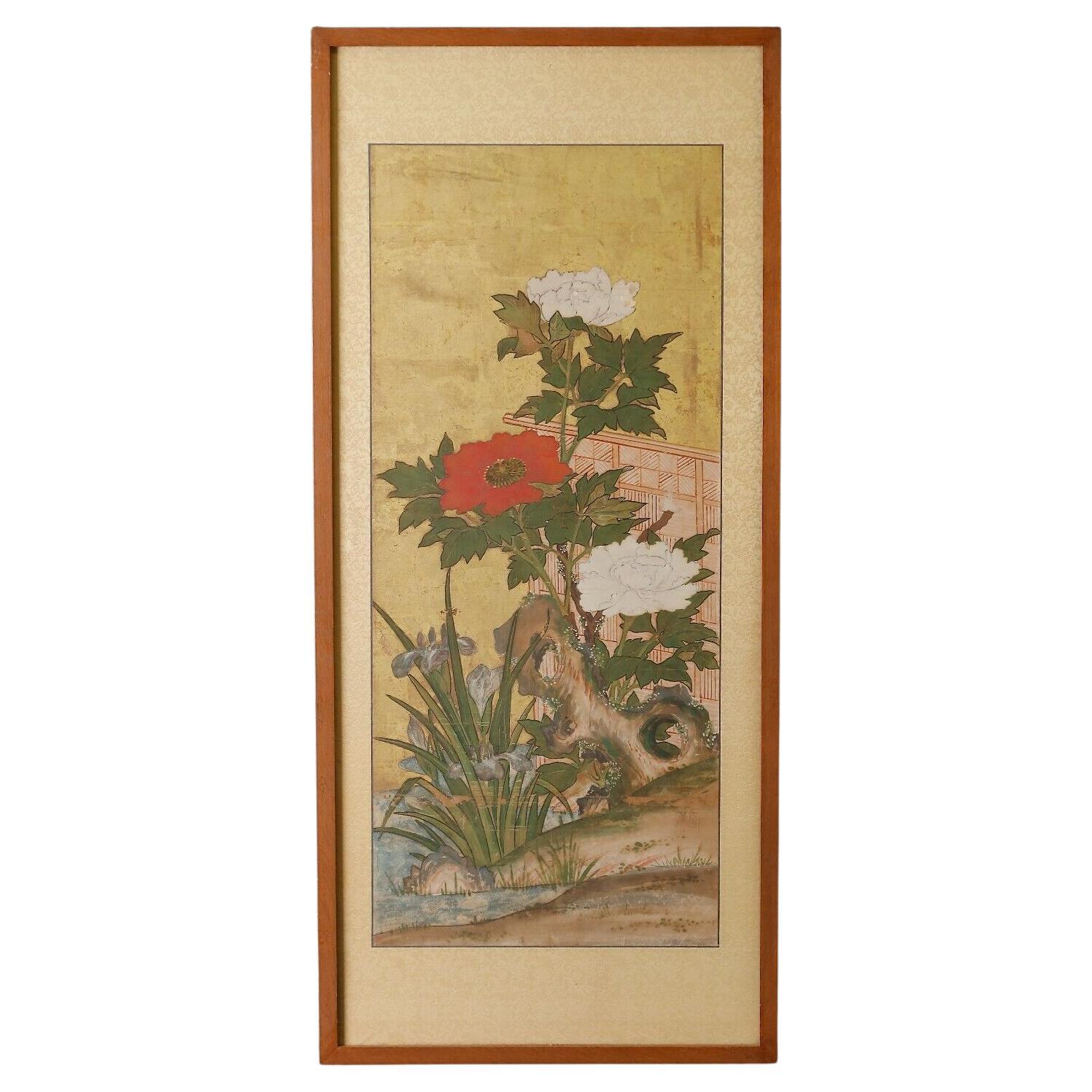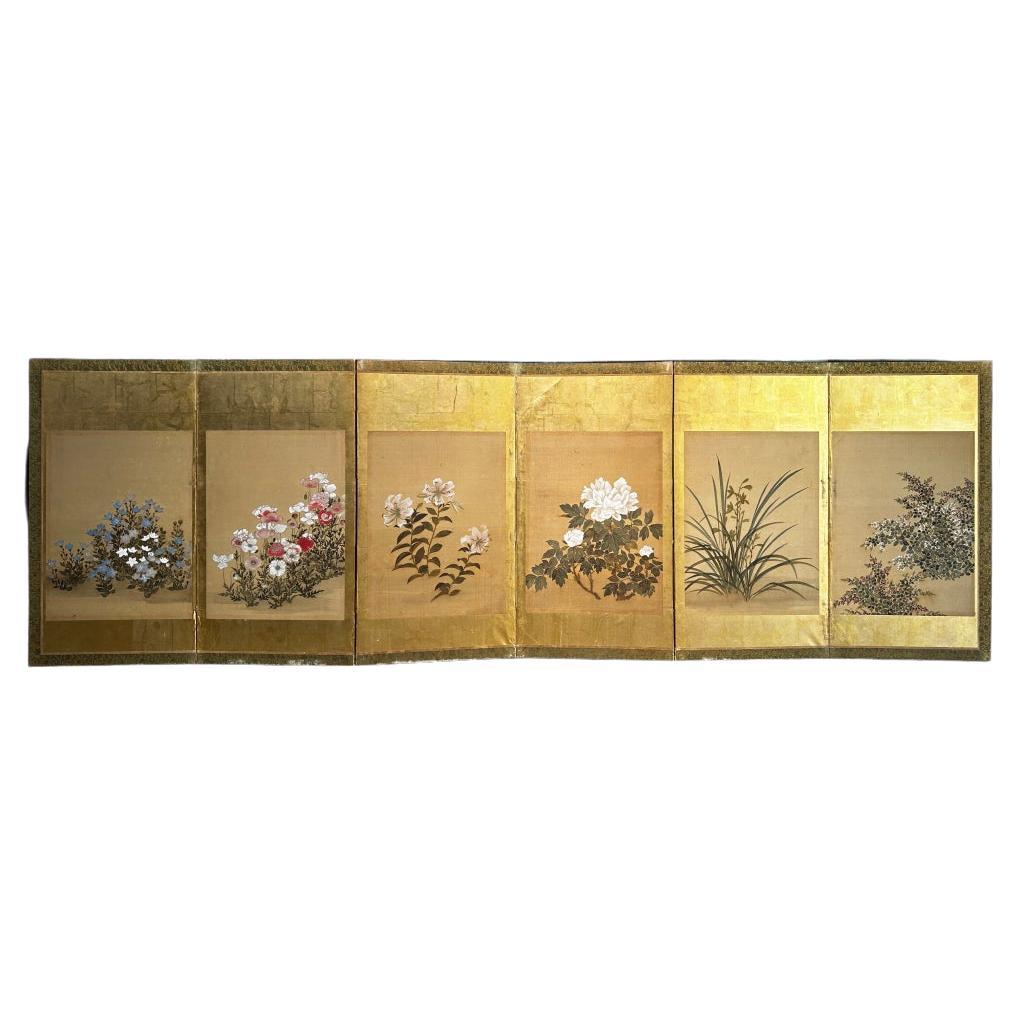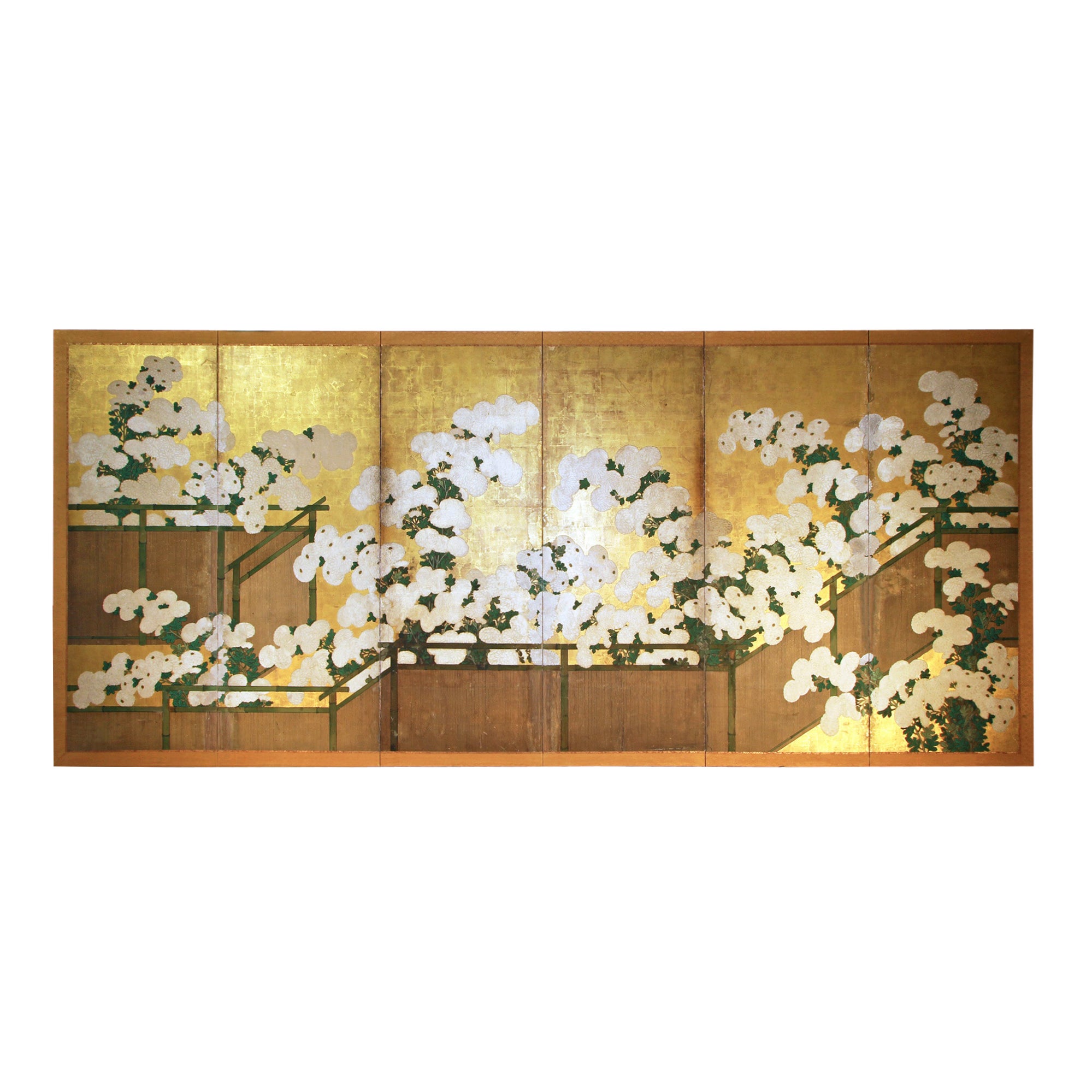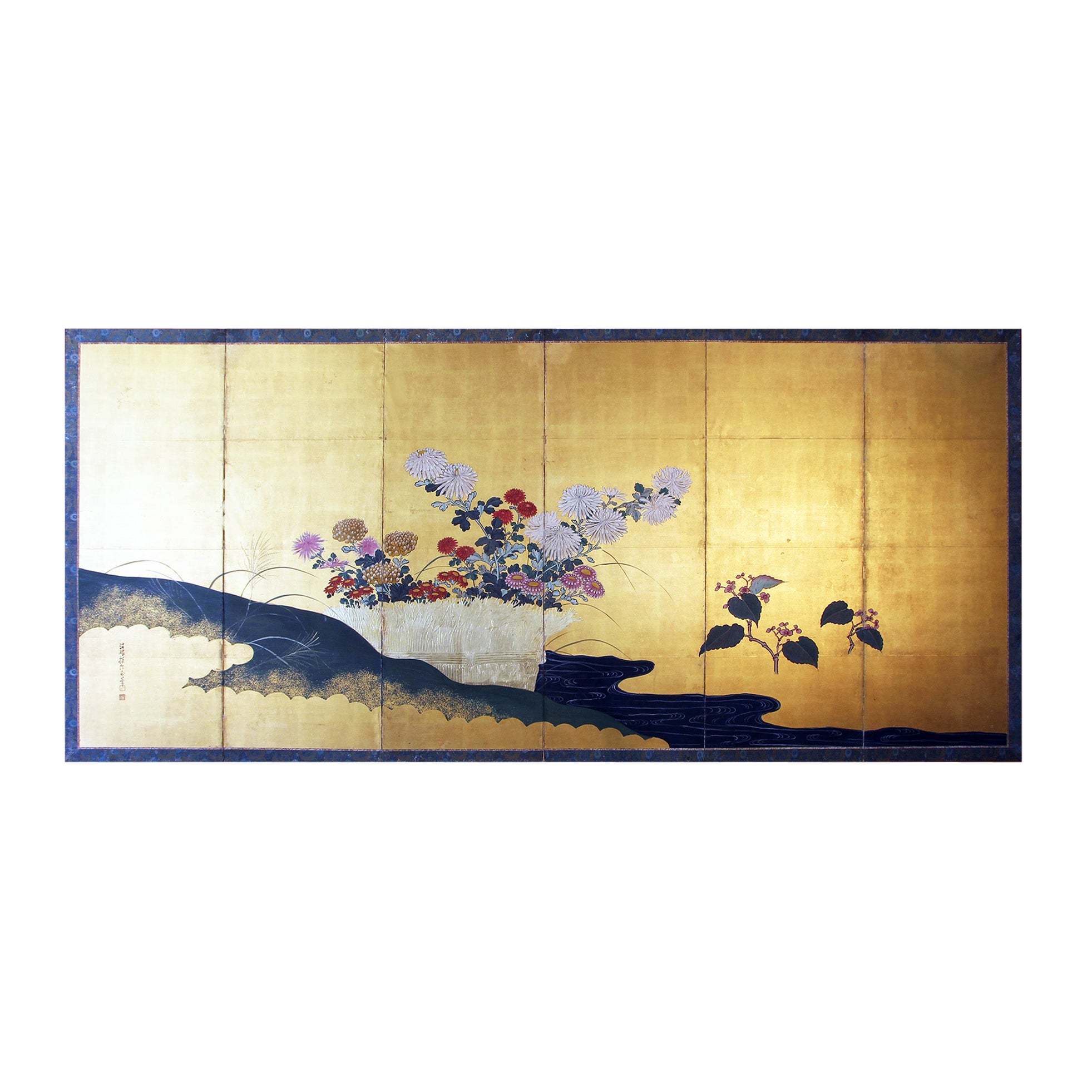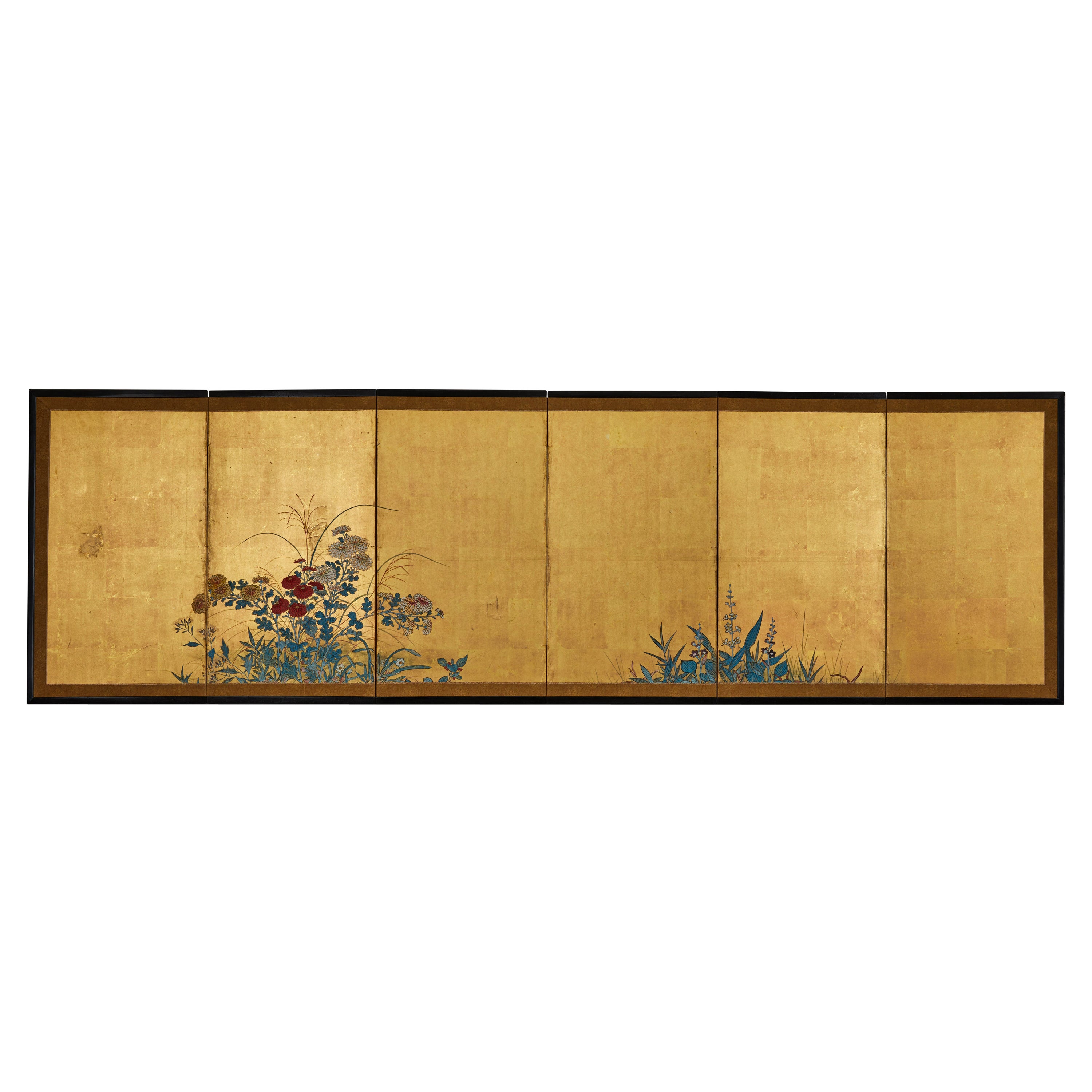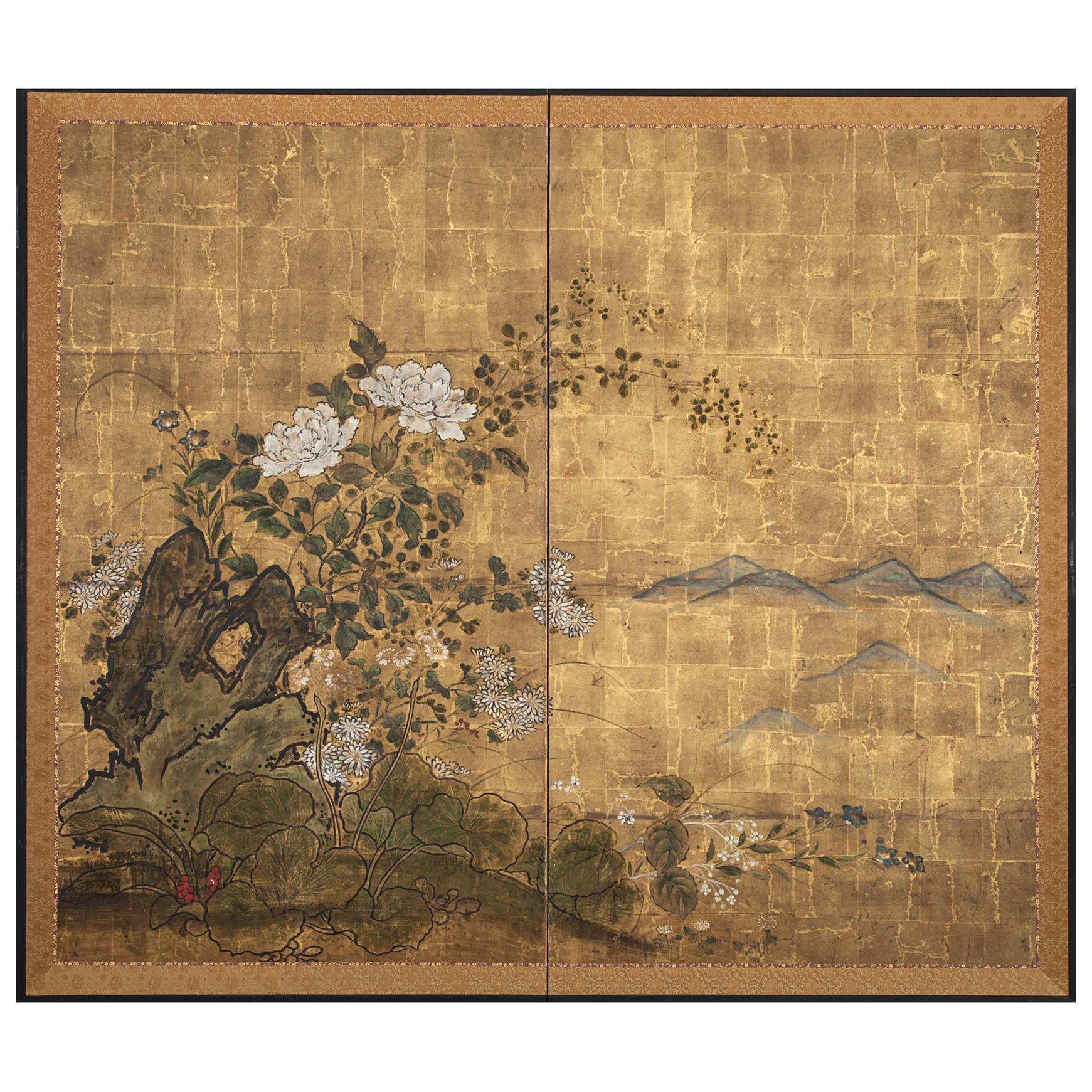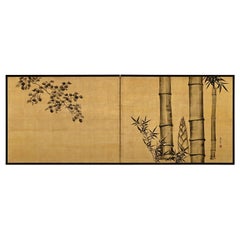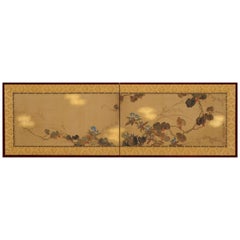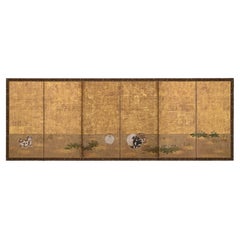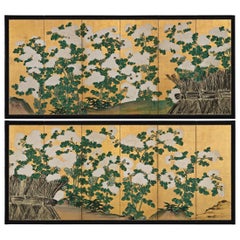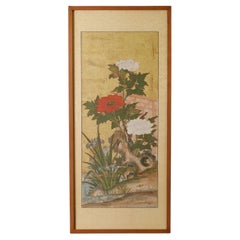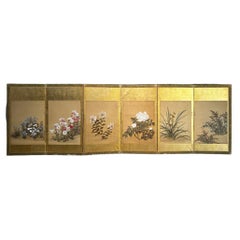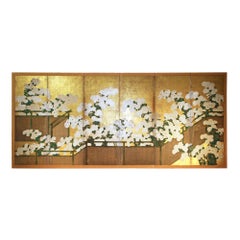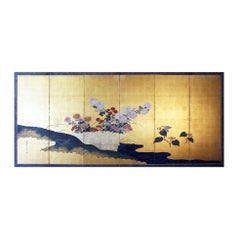Items Similar to 18th Century Japanese Floral Paintings, Set of 5, Mineral Pigments on Gold Leaf
Want more images or videos?
Request additional images or videos from the seller
1 of 6
18th Century Japanese Floral Paintings, Set of 5, Mineral Pigments on Gold Leaf
$3,800per set
£2,885.43per set
€3,299.70per set
CA$5,309.15per set
A$5,904.93per set
CHF 3,083.37per set
MX$71,856.78per set
NOK 39,379.38per set
SEK 36,930.92per set
DKK 24,626.96per set
Shipping
Retrieving quote...The 1stDibs Promise:
Authenticity Guarantee,
Money-Back Guarantee,
24-Hour Cancellation
About the Item
A set of 5 Japanese floral paintings from the 18th century. Each painted with mineral pigments directly applied to gold leaf. They were originally designed to be mounted on the leaves of a book; to be appreciated both for their exceptional beauty and also to aid in the identification of the flowers and their associated seasons. Presently the paintings are individually backed with Japanese washi paper and are ready to be inserted into Western style frames.
The leaves are slightly irregularly sized, the tallest measuring 12.8 cm and the shortest measuring 11.5 cm (5” ~ 4.5”). The widest is 10.7 cm and the narrowest is 9.9 cm (4.2” ~ 3.9”).
- Dimensions:Height: 5 in (12.7 cm)Width: 4.2 in (10.67 cm)Depth: 0.01 in (0.26 mm)
- Sold As:Set of 5
- Style:Edo (Of the Period)
- Materials and Techniques:
- Place of Origin:
- Period:
- Date of Manufacture:circa 1750
- Condition:Wear consistent with age and use.
- Seller Location:Kyoto, JP
- Reference Number:1stDibs: LU2472317053131
About the Seller
5.0
Recognized Seller
These prestigious sellers are industry leaders and represent the highest echelon for item quality and design.
Established in 2001
1stDibs seller since 2016
70 sales on 1stDibs
Typical response time: 6 hours
- ShippingRetrieving quote...Shipping from: Kyoto, Japan
- Return Policy
Authenticity Guarantee
In the unlikely event there’s an issue with an item’s authenticity, contact us within 1 year for a full refund. DetailsMoney-Back Guarantee
If your item is not as described, is damaged in transit, or does not arrive, contact us within 7 days for a full refund. Details24-Hour Cancellation
You have a 24-hour grace period in which to reconsider your purchase, with no questions asked.Vetted Professional Sellers
Our world-class sellers must adhere to strict standards for service and quality, maintaining the integrity of our listings.Price-Match Guarantee
If you find that a seller listed the same item for a lower price elsewhere, we’ll match it.Trusted Global Delivery
Our best-in-class carrier network provides specialized shipping options worldwide, including custom delivery.More From This Seller
View All19th Century Japanese Screen for Tea-Ceremony, Ink Bamboo and Plum on Gold Leaf
Located in Kyoto, JP
Three Friends of Winter
Nakajima Raisho (1796-1871)
Late Edo period, circa 1850
Ink and gold leaf on paper.
This is a double-sided Japanese Furosaki or tea-ceremony screen from the mid 19th century; bamboo and plum on the front, young pines the back. It by Nakajima Raisho, a master painter of the Maruyama school in the late Edo and early Meiji periods. In this work Raisho combines exquisite ink brushwork with large open spaces of brilliant gold-leaf to inspire the viewers imagination. Rather than naturalism, he is searching for the phycological impression of the motifs, resulting in abstraction and stylization. His simplification of the motifs the result of looking to capture the inner nature of the objects. This art motif is known as Sho Chiku Bai, or the Three Friends of Winter. Evergreen pine connotes steadfastness, bamboo suggests both strength and flexibility, while plum blossoms unfurling on snow-laden branches imply hardiness. Combined, this trio is emblematic of Japanese new year. Chinese literati were the first to group the three plants together due to their noble characteristics. Like these resilient plants flowering so beautifully in winter, it was expected of the scholar-gentleman to cultivate a strong character with which he would be able to show the same degree of perseverance and steadfastness even during times of adverse conditions.
The screen would have been placed near the hearth of a room used for the Japanese tea ceremony, shielding the fire from draughts and also forming a stimulating and decorative backdrop behind the tea utensils. It would have been used in the Hatsugama, or first tea-ceremony of the new year.
Nakajima Raisho (1796-1871) originally studied under Watanabe Nangaku before entering the school of Maruyama Ozui. He was the highest ranking Maruyama school painter at the end of the Edo period and was known as one of the ‘Four Heian Families’ along with Kishi...
Category
Antique Mid-19th Century Japanese Edo Paintings and Screens
Materials
Gold Leaf
Japanese Screen Painting, Early 19th Century, Autumn Flowers by Sakai Hoitsu
Located in Kyoto, JP
A two-fold Japanese screen by the Rimpa school artist Sakai Hoitsu (1761-1828), Japan, 19th century, Edo period.
This small Japanese folding screen pai...
Category
Antique Early 19th Century Japanese Edo Paintings and Screens
Materials
Wood, Silk
Late 17th Century Japanese Screen. Puppy and Kittens on Gold Leaf.
Located in Kyoto, JP
Anonymous
Late 17th century
Puppy & Kittens
A six-panel Japanese screen. Ink, color, gofun, gold-leaf and gold-fleck on paper.
A medium sized late 17th century Japanese screen fe...
Category
Antique Late 17th Century Japanese Edo Paintings and Screens
Materials
Gold Leaf
Mid-18th Century Japanese Screen Pair, One Hundred Flowers, Chrysanthemums
Located in Kyoto, JP
Omori Soun (b. 1704)
Chrysanthemums - One Hundred Flowers
A Pair of Six-fold Japanese Screens. Ink, color, gofun and gold leaf on paper.
Dating ...
Category
Antique Mid-18th Century Japanese Edo Paintings and Screens
Materials
Gold Leaf
Mid 19th Century Framed Japanese Painting. Grasshopper & Hibiscus.
Located in Kyoto, JP
Obata Tosho (1812-1886)
Grasshopper & Hibiscus.
Late Edo period, mid 19th Century
Framed Japanese Painting. Ink and color on paper.
Individually framed 19th century bird and flow...
Category
Antique Mid-19th Century Japanese Edo Paintings and Screens
Materials
Paper
Early 20th Century Japanese Screen. Flowers of the Four Seasons.
Located in Kyoto, JP
Anonymous
Flowers of the Four Seasons
A four-panel Japanese screen. Ink, gofun and pigments on gold leaf.
This Japanese screen is a rich visual celebration of the flowers of the fo...
Category
Early 20th Century Japanese Taisho Paintings and Screens
Materials
Gold Leaf
You May Also Like
Edo Period (19th) Japanese antique painting of flowers
Located in Fukuoka, JP
Japanese antique painting of flowers 19 C
Weight 3kg ( 6.6lb)
Category
Antique Mid-19th Century Japanese Edo Paintings and Screens
Materials
Silk, Paper
Edo Period Rimpa School Golden Screen - Summer Florals
By Rimpa School
Located in Fukuoka, JP
Edo Period Golden Screen - Summer Florals
Period: Edo
Size: 285 x 92.5 cm (112.2 x 36.4 inches)
SKU: PTA141
This Edo period screen is a golden-framed window into the summer gardens...
Category
Antique 18th Century Japanese Edo Paintings and Screens
Materials
Gold Leaf
Japanese Screen mid Edo gold leaf
By Japanese Studio
Located in Brescia, IT
This 18th century six-panel screen is truly special. The author is unknown, but his singular genius in portraying dozens of chrysanthemum flowers created with the white of the "gofun...
Category
Antique Mid-18th Century Japanese Edo Paintings and Screens
Materials
Gold Leaf
Japanese Byobu - Japanese Folding Screen Gold Leaf
By Japanese Studio
Located in Brescia, IT
Floral scene of a "Rimpa School" garden with polychrome chrysanthemum flowers.
Six-panel screen painted with pigments on golden rice paper of good size and well preserved.
Bold color...
Category
Antique Early 19th Century Japanese Edo Paintings and Screens
Materials
Gold Leaf
Japanese Six Panel Screen: Rimpa Style Summer Flowers on Gold
Located in Hudson, NY
Red and yellow chrysanthemums and pampass grasses. Meiji period (1868 - 1912), Rimpa style painting in mineral pigments on mulberry paper with a silk brocade border.
Category
Antique Late 19th Century Japanese Paintings and Screens
Materials
Brocade, Silk, Paper
Japanese Two-Panel Screen, Floral Garden on Gold
Located in Hudson, NY
Peonies, marigolds and pinks next to a garden stone with soft mountain peaks in the background. Late Edo (1603 - 1868) period painting in mineral pigmen...
Category
Antique Early 19th Century Japanese Edo Paintings and Screens
Materials
Gold Leaf
More Ways To Browse
Mineral Art
Antique Mineral
Floral Screen
Japanese Washi
Asian Gold Leaf Art
Gold Leaf Screen
18th Century Flower Paintings
Mounted Minerals
18th Century Screen
Antique Japanese Book
Floral Paintings 18th Century
Antique Gold Leaf Screens
Japanese Screen Gold Leaf
18th Century Hand Screen
Edo Screen Gold
18th Century Japanese Screens
Japanese Painted Screen Floral
Japanese Wood Panel
